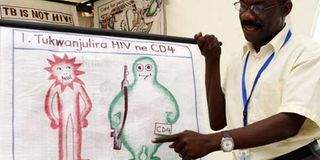Infidelity stalls war on Aids, new research shows

An Aids educator explains about CD4 cells. The study says both husbands and wives should be targeted in awareness campaigns. PHOTO | MORGAN MBABAZI
What you need to know:
- The study, aimed at establishing the factors fuelling HIV prevalence among fishing communities, pointed towards cheating by fishermen’s wives
- One finding was that women whose husbands denied them their preferred sex position were more likely to look for satisfaction outside marriage
Researchers have warned that infidelity could reverse the gains made in HIV prevention and management.
Kenya Medical Research Institute scientist Zachary Kwena, who led a nine-month study on cheating spouses on the shores of Lake Victoria, called for programmes addressing extra-marital affairs.
The study, Predictors of Extra-Marital Partnerships among Women Married to Fishermen along Lake Victoria in Kisumu County, Kenya, was published last week in PLOS journal.
It looks at why wives cheated on their husbands.
The researchers first obtained a list of all fishermen and then with the help of beach management officials, made a second list of married fishermen between ages 18 and 45 and got respondents from all the 33 fishing beaches in Kisumu County.
The study, aimed at establishing the factors fuelling HIV prevalence among fishing communities, pointed towards cheating by fishermen’s wives.
“Women should also be included in HIV prevention and management programmes so that we can tackle the problem from all fronts,” Dr Kwena told the Nation in an interview on Thursday.
According to the study, 6.2 per cent of the women respondents cheated on their spouses.
Dr Kwena said this should be a focal point when rolling out HIV prevention programmes.
“We should be worried about these findings especially because they are some of the highest compared to other studies given the HIV prevalence in Nyanza region that stands at about one in four persons,” Dr Kwena said.
The findings validate last year’s conclusions by the National Aids Control Council that couples and those in stable relationships account for the highest percentage of new HIV/Aids infections in Kenya.
Dr Kwena also found out that women below 25 years were more likely to cheat on their husbands.
Respondents gave various reasons for cheating, including domestic violence, with assaulted women seeking solace from lovers.
Women who experienced pain during sex with their spouses were also more likely to cheat.
TRADITIONAL INSTITUTIONS
Another finding was that women whose husbands denied them their preferred sex position were more likely to look for satisfaction outside marriage, as were those whose husbands failed to satisfy them.
According to Dr Kwena, modern society has seen a proliferation and glorification of extra-marital affairs, attributing this to a collapse of traditional institutions that mentored young men and women.
“While young women had their grandmothers and aunts to learn from, young men had grandfathers to learn from at dusk after work,” noted Dr Kwena.
This system, he said, saw the mentoring of young people on their marital and family life obligations.
The study also found that despite their husbands being away on fishing expeditions for long periods, the women did not cite the separation as one of the reasons for cheating.
“We did not find any association between women’s physical separation from their spouses and their involvement in extra-marital partnerships,” Dr Kwena said.
The study was carried out jointly with Prof Elizabeth Bukusi and Ms Lilian Achiro from Kemri’s Centre for Microbiology Research; Prof Chris Chisanya of Kenyatta University’s Department of Geography and Dr Isaac Mwanzo from the Department of Community Health.
Others were Ms Carol Camlin of the Department of Obstetrics, Gynaecology and Reproductive Sciences, University of California and Ms Janet Turan of the Department of Health Care Organisation and Policy, University of Alabama, both in the United States.
The study was carried out between September 2011 and June 2012.
RISK FACTORS
The authors said marriage has consistently been reported as one of the risk factors for HIV infection partly due to extra-marital partnerships of one or both spouses in the context of low or no condom use.
“Spouses involved in unprotected extra-marital sex act as conduits through which HIV enters marriages whose partners were hitherto concordant negative,” reads an excerpt of the introduction of the paper.
“More importantly, fishing communities along Lake Victoria are reported to commonly engage in high risk sexual behaviour and have high HIV prevalence rates of up to 26.5 per cent compared to the regional and Kenyan national average of 15.1 per cent and 5.6 per cent, respectively,” the research said quoting data from both Nascop and NACC.




